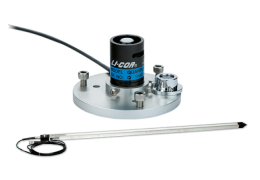Calculate the LI-190R Calibration Multiplier
Printable PDF: Calculate the LI-190R Calibration Multiplier
Instructions for determining the LI-190R calibration multiplier for sensors purchased from Campbell Scientific.
LI-COR Sensors such as the LI-190R or older LI-190 Quantum Sensor can be purchased through Campbell Scientific, Inc. Campbell Scientific obtains these sensors from LI-COR and subsequently performs some modifications to the cable, as well as placing a resistor across the leads to convert the signal from current to voltage. The sensor is sold by Campbell Scientific with the model name ‘LI190SB Quantum Sensor’. If is it unclear where the sensor was purchased, sensors that come from Campbell Scientific will have a modified cable terminating with three wires (red, black, and clear) as opposed to two wires (clear and shield) when the sensor comes directly from LI-COR.
The shunt resistor that Campbell Scientific installs in the sensor’s cable is a 604 Ohm precision resistor that is supplied by LI-COR. The resistor is sealed in the cable and due to its size, may not be able to be detected.
Make sure that the LI-190R is wired correctly to the data logger to record measurements from this sensor. Program the Campbell Scientific data logger channel to measure Differential Voltage. Wire the Red wire into the ‘H’ channel. Wire the black wire into the ‘L’ channel. Wire the clear wire into the GND channel. In addition, place a jumper wire from the ‘L’ channel to an ‘AG’ channel to further eliminate noise. For further details on this, refer to the Campbell Scientific website and the ‘LI190SB’ Manual.
After the LI-190R Sensor has been wired into a data logger to measure the voltage signal, a multiplier is needed to convert the voltage signal into units of mol s-1 m-2. Campbell Scientific may have provided this multiplier when the sensor was purchased or last calibrated. However, if the multiplier information is lost, it can be calculated using the Calibration Constants from when the sensor was last calibrated at LI-COR. Below are the instructions on how to compute a LI-COR Sensor’s current-based Calibration Constant into a voltage-based multiplier.
Each LI-190R Quantum Sensor that LI-COR manufactures (and is sold through Campbell Scientific), possesses a particular Calibration Constant specific to that sensor. This Constant is provided on the Sensor's Calibration Sheet. There are actually two coefficients listed on a LI-COR Calibration Certificate. There is a Calibration Constant ('C' Amps per 1000 mol s-1 m-2) and a Calibration Multiplier ('-M' mol s-1 m-2 per Amp). The Multiplier on this LI-COR certificate is typically used when utilizing our LI-COR LI-1400 Datalogger or the LI-250A Light Meter. Below are the equations to obtain the correct multiplier for a voltage-reading data logger:
First convert the output units of the Calibration Constant from a Current into a Voltage:
1
The multiplier would then be the negative reciprocal of this:
2
This equation can also be found in the Terrestrial Radiation Sensors Manual.
Here is an example calculation using information from a Sample Sensor. From the Calibration Sheet, the Calibration Constant is:
Using the above equation, convert the Calibration Constant output units from a Current to a Voltage using the Resistor value of 604 ohms (in the 2290 Millivolt Adapter):
3
The negative reciprocal of this would compute the multiplier for this particular sensor:
4
Campbell Scientific data loggers have the ability to measure down into the microvolt (or 0.1 millivolt) range, which is ideal for the LI-COR Sensors. To further increase sensitivity, make sure the voltage range of the channel is set as close as possible to the full-scale range of the Sensor. For example, set the Range of the voltage channel to read from 0-to-25 mV, which should cover the range of values expected in a natural sunlight environment. Some of the Campbell Scientific data loggers can have ranges set to 10 mV. Again, reference the ‘LI190SB’ Manual from Campbell Scientific for further details on this.
